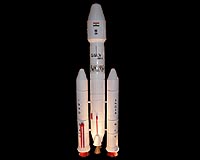 |
Cape Canaveral, Florida (AFP) Oct 28, 2009 NASA successfully launched Wednesday the prototype for a new generation of space rocket, advancing its plans to return man to the Moon by 2020. The Ares I-X, the tallest rocket ever built, blasted off at 11:30 am (1530 GMT) from Cape Canaveral in Florida, carrying with it the US space agency's lofty ambitions for human space flight. The rocket is the prototype of the Ares I, designed to carry a new capsule-shaped crew module called the Orion into low Earth orbit for missions to the International Space Station, the Moon, and beyond. "I can't say enough about this team," said Doug Cooke, associate administrator for the Exploration Systems Mission Directorate at NASA headquarters in Washington. "They've been together probably a little over three years now, and they went from a concept to flying this vehicle in that period of time, which is the first time this has been done by a human spaceflight team in a long time." After a frustrating Tuesday, when several attempts to launch were abandoned, the clouds finally parted long enough for the syringe-like rocket to shoot up into the blue sky above the Kennedy Space Center. The booster section of the 327-foot (100-meter) rocket separated from a simulated upper stage after two and a half minutes before dropping to Earth and splashing down in the Atlantic awaiting retrieval. "It's the most beautiful rocket launch I have ever seen," said program director Jeff Hanley when the applause had died down in the NASA control room. "I get tears in my eyes. It was very special." More than 700 sensors should provide engineers with important data for fine-tuning the design of the rocket that with Orion is intended to replace NASA's aging fleet of space shuttles, which is due to be retired in 2010. "The vehicle flew well and we are going to get a lot of data back and we are going to learn a lot that will stand us in good stead for the future," Cooke told a press conference. NASA said the data gathered from the 445-million-dollar launch -- the first time in 30 years that a space craft other than a shuttle has blasted off from the Kennedy Space Center -- would take several months to analyze. Ares and Orion are part of Constellation, NASA's grand program to send astronauts back to the Moon by 2020, and then perhaps to Mars and other destinations in the solar system. Although the shuttle is to be retired next year, the Ares I will not enter into service until 2015 at the earliest. In the interim, NASA will have to rely on Russia to put US astronauts into space, at a hefty price, too. The Orion is initially being designed to take a crew of up to six astronauts on flights to the International Space Station, or four on lunar missions of up to 210 days. Instead of landing like a plane as the shuttle does, it will float back to Earth using parachutes, more like the Apollo module that took Neil Armstrong, Michael Collins and Buzz Aldrin to the Moon more than 40 years ago. The Orion perches atop the Ares rocket and NASA has incorporated a special launch abort system to enable the capsule to jettison out of harm's way should something go wrong. The test flight comes at a crucial time as the White House is considering a report ordered by President Barack Obama's administration that raises concerns about the whole Constellation project. A commission, chaired by Norman Augustine, a former executive at aerospace giant Lockheed Martin, concluded that the program "appears to be on an unsustainable trajectory" and was seeking goals not matched by its resources. The Ares rocket has suffered major development problems and its price tag has fueled criticism of NASA, an agency notorious for its cost overruns. The initial budget for the Constellation program was set at 28 billion dollars, but has swollen to at least 44 billion. NASA's annual budget is about 18 billion dollars, 10 billion of which is being plowed into the human space flight program, chiefly in developing the Ares and the Orion. The Augustine Commission said an additional three billion dollars a year was needed for NASA to meet Constellation program goals or take human space flight the next step beyond the existing International Space Station. The commission proposed several alternatives, including sidestepping the rocket and going straight to the Ares V family of launch vehicles, which would take astronauts back to the Moon and eventually on to Mars. Share This Article With Planet Earth
Related Links Rocket Science News at Space-Travel.Com
 India Set To Join Exclusive Cryogenic Club
India Set To Join Exclusive Cryogenic ClubChennai, India (PTI) Oct 28, 2009 After its maiden moon mission, the Indian Space Research Organisation (ISRO) is hoping to cross another milestone in December - take India into the exclusive club of countries that have developed their own cryogenic engines to power satellites in space. ISRO is hoping to end 2009 in style with the take-off of its fully indigenous geosynchronous satellite launch vehicle (GSLV) carrying an ... read more |
|
| The content herein, unless otherwise known to be public domain, are Copyright 1995-2009 - SpaceDaily. AFP and UPI Wire Stories are copyright Agence France-Presse and United Press International. ESA Portal Reports are copyright European Space Agency. All NASA sourced material is public domain. Additional copyrights may apply in whole or part to other bona fide parties. Advertising does not imply endorsement,agreement or approval of any opinions, statements or information provided by SpaceDaily on any Web page published or hosted by SpaceDaily. Privacy Statement |